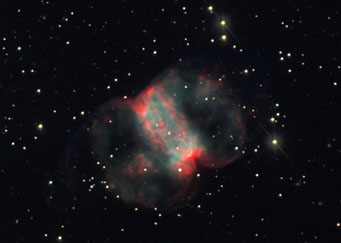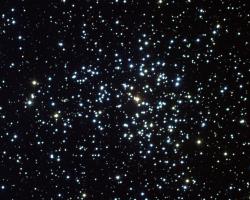It was Jay Freeman who gave me the idea of observing all the Messier objects with each instrument that I own. It's turned out to be a very useful habit. It gives me an excellent sense of the instrument's capabilities, while also reinforcing my memory of where each object is, what it looks like, and how to find it. Ideally, I'd like to be able to find every Messier object with every instrument at every level of light pollution by memory — though that's obviously a utopian goal that can only be approached, never completely realized.

The small size and low total brightness of M76, the Little Dumbbell, make it one of the few Messier objects that's even a little hard to see in 15×70 binoculars.
Adam Block / NOAO / AURA / NSF
Ever since purchasing my 15×70 binoculars, I've been reminded of Jay's comment that 70-mm binoculars are the easiest instruments for doing a Messier survey. They can be swiveled very quickly, yet they're big enough so that most of the Messier objects pop out instantly as soon as they enter the vast field of view — assuming that I'm under reasonably dark skies.
Last weekend was late first-quarter Moon, so I had to get up before dawn for deep-sky observing. I ended up chasing down all the early-winter Messier objects — the ones between RA 0 and RA 6 — in a few minutes using my 15×70 binoculars. Only when I was writing down my notes a couple of days later did I realize that this had completed my Messier survey with that instrument.

Even small telescopes resolve Messier 37 into a swarm of stars at high magnifications. But through 15×70 binoculars it's just a cloud of light.
NOAO / AURA / NSF
After my quick scan, I went back to view each of the objects more carefully. And here's where one of the drawbacks of binoculars became painfully apparent. One of the reasons that I can find deep-sky objects so quickly with binoculars is that once found, the objects display depressing little detail. So I'm not tempted to linger over each object as I would be if using a telescope. There are a few star clusters (the Pleiades, for instance) that really sparkle at 15×, but they're the rare exceptions.
Still, there were a few pleasant surprises. For instance, I was able to make out the outer loop of the Orion Nebula — the one that's almost 1° in diameter, passing near Iota Orionis. That's not an easy target even in telescopes with significantly more aperture. It's a reminder that using two eyes is especially valuable for viewing subtle nebulosity.
I do finally understand why 15×70 binoculars are popular with some beginners, though. For simply tracking down deep-sky objects — as opposed to seeing detail in them — the combination of the binoculars' enormous field of view, straight-through pointing, and pretty-huge light grasp is hard to beat. That could avoid a lot of the frustration that many beginners experience.
 4
4









Comments
Zooball
September 28, 2007 at 3:33 pm
My first observing list was Phil Harrington's Star Watch book. I completed it with my Orion (Vixen) 30x80 binoculars, and found it to be a thoroughly enjoyable experience. There was only a few double stars that I could not split, but M40 was an easy target. 😉
You can see my results at #3 here: http://www.philharrington.net/hallfame.htm I also earned an Astronomical League Binocular Messier Club Certificate for the same effort. But also notice on the Star Watch Hall of Fame page most of the observers used binoculars for at least part of this book. They are simply the best tool for wide objects.
I completely agree that using binoculars, even giant ones, is probably the easiest way for a beginning observer to get into completing "easy" observing lists like the Messier catalog. And, for my "return visits" of the Messier Catalog, I used a 12 inch Starfinder dobsonian combined with my binocular experience of knowing what to see and where.
Earlier this year I got 110 objects in a Messier Marathon with the Starfinder, but I really want to go back and try it again with the binoculars!
You must be logged in to post a comment.
Mike Prochoda
October 6, 2007 at 9:44 pm
Medium-size binoculars make excellent tools for finding the Messier objects. Last March (3/17 to 3/18/07) I participated in a Messier Marathon using both my 140mm refractor and my Pentax 16 x 60 binoculars mounted on an observing chair. I only missed M30 with the refractor (too close to the rising sun) and was able to bag all of the Messiers I attempted except M74. M2, M72, M73, and M30 were not even attempted using the binos, as I was too busy trying to find these objects in the brightening dawn sky using my refractor. I have subsequently easily observed all of these "missed" Messier objects with the same Pentax 16 x 60 binoculars when the objects were well-placed in the sky. My impression is that you could probably get all of the Messiers with 15 x 50 binoculars by knowing just where to look and having the binoculars firmly mounted. Does anyone know what the smallest aperture or lowest power binoculars are - that have been used to "bag" all 110 Messier objects?
You must be logged in to post a comment.
Mike Prochoda
October 6, 2007 at 9:44 pm
Medium-size binoculars make excellent tools for finding the Messier objects. Last March (3/17 to 3/18/07) I participated in a Messier Marathon using both my 140mm refractor and my Pentax 16 x 60 binoculars mounted on an observing chair. I only missed M30 with the refractor (too close to the rising sun) and was able to bag all of the Messiers I attempted except M74. M2, M72, M73, and M30 were not even attempted using the binos, as I was too busy trying to find these objects in the brightening dawn sky using my refractor. I have subsequently easily observed all of these "missed" Messier objects with the same Pentax 16 x 60 binoculars when the objects were well-placed in the sky. My impression is that you could probably get all of the Messiers with 15 x 50 binoculars by knowing just where to look and having the binoculars firmly mounted. Does anyone know what the smallest aperture or lowest power binoculars are - that have been used to "bag" all 110 Messier objects?
You must be logged in to post a comment.
10 Minute Astronomy
January 7, 2010 at 12:37 pm
> Does anyone know what the smallest aperture or
> lowest power binoculars are - that have been used
> to "bag" all 110 Messier objects?
Jay Freeman reports bagging all 110 with 7x50 binoculars, although not in a marathon. He also did the Herschel 400 with a 55mm refractor.
http://web.mac.com/Jay_Reynolds_Freeman/My/Astronomy.html
You must be logged in to post a comment.
You must be logged in to post a comment.